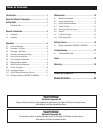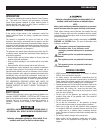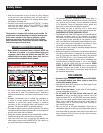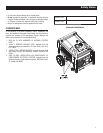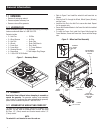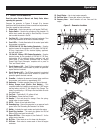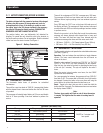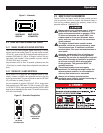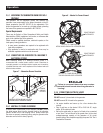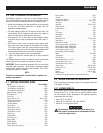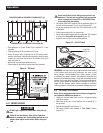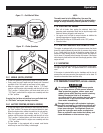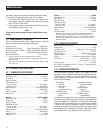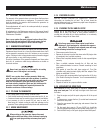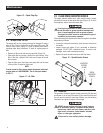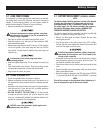
8
2.5.1 GROUNDING THE GENERATOR WHEN USED AS A
PORTABLE
This generator has an equipment ground that connects the
generator frame components to the ground terminals on the AC
output receptacles (see NEC 250.34 (A) for explanation). This
allows the generator to be used as a portable without grounding
the frame of the generator as specified in NEC 250.34.
Special Requirements
There may be Federal or State Occupational Safety and Health
Administration (OSHA) regulations, local codes, or ordinances that
apply to the intended use of the generator.
Please consult a qualified electrician, electrical inspector, or the
local agency having jurisdiction:
• In some areas, generators are required to be registered with
local utility companies.
• If the generator is used at a construction site, there may be
additional regulations which must be observed.
2.5.2 CONNECTING THE GENERATOR TO A BUILDING’S
ELECTRICAL SYSTEM
When connecting directly to a building's electrical system, it is
recommended that a manual transfer switch is used. Connections for
a portable generator to a building's electrical system must be made by
a qualified electrician and in strict compliance with all national and local
electrical codes and laws.
Figure 7 – Generator Ground Location
XG6500 & XG7000 GROUND LOCATION
AND BRUSHED ALTERNATOR XG8000
XG8000
GROUND
LOCATION
2.5.3 NEUTRAL TO FRAME GROUNDING
If service work is performed on the alternator, DO NOT discard
the white jumper wires from the terminal block to the alternator
ground, located on the rear bearing carrier. Always make sure
the wires are properly connected before using the generator after
alternator service work is done (Figure 8).
Figure 8 – Neutral to Frame Ground
NEUTRAL TO FRAME GROUND XG6500,
7000 AND 8000 BRUSHED ALTERNATOR
DO NOT DISCARD
THESE WIRES!
NEUTRAL TO FRAME GROUND
XG7000 & 8000 BRUSHLESS ALTERNATOR ONLY
DO NOT DISCARD
THESE WIRES!
Failure to reconnect these wires may create a
potential shock hazard when the generator is
running!
2.5.4 CONNECTING ELECTRICAL LOADS
DO NOT connect 240 Volt loads to 120 Volt receptacles.
DO NOT connect 3 phase loads to the generator.
DO NOT connect 50 Hz loads to the generator.
• Let engine stabilize and warm up for a few minutes after
starting.
• Plug in and turn on the desired 120 or 240 Volt AC, single
phase, 60 Hz electrical loads.
• Add up the rated watts (or amps) of all loads to be connected
at one time. This total should no be greater than (a) the rated
wattage/amperage capacity of the generator or (b) circuit
breaker rating of the receptacle supplying the power. See “Don’t
Overload the Generator
Operation



